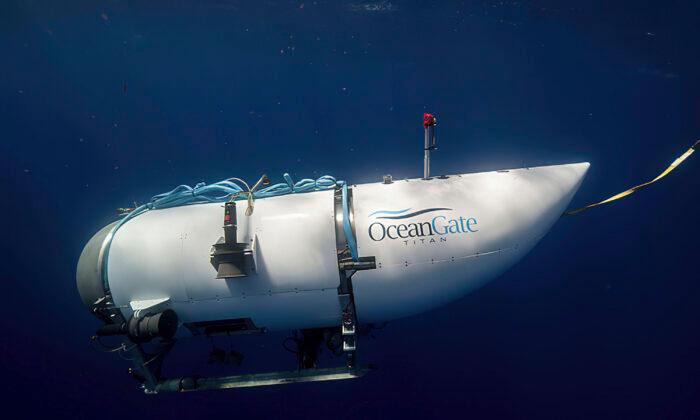Authorities hunted Friday for the reason a submersible carrying people to the wreck of the Titanic imploded deep in the North Atlantic, as questions emerged about how such expeditions are regulated and tributes poured in for the five aboard who were killed.
The announcement that no one survived Thursday brought a tragic end to a five-day saga that included an urgent around-the-clock search for the vessel known as the Titan.
The investigation into what happened was already underway and would continue in the area around Titanic where debris from the submersible was found, said Rear Adm. John Mauger, of the First Coast Guard District.
“I know there are also a lot of questions about how, why, and when did this happen. Those are questions we will collect as much information as we can about now,” Mauger said, adding that it was a “complex case” that happened in a remote part of the ocean and involved people from several different countries.
Those killed were Stockton Rush, the CEO of OceanGate Expeditions, the company that owned and operated the submersible; two members of a prominent Pakistani family, Shahzada Dawood and his son Suleman Dawood; British adventurer Hamish Harding; and Titanic expert Paul-Henri Nargeolet.
The Titan launched at 6 a.m. Sunday, and was reported overdue Sunday afternoon about 435 miles (700 kilometers) south of St. John’s, Newfoundland. Rescuers rushed ships, planes, and other equipment to the site of the disappearance.
Any sliver of hope that remained for finding the crew alive was wiped away early Thursday, when the submersible’s 96-hour supply of air was expected to run out and the Coast Guard announced that debris had been found roughly 1,600 feet (488 meters) from the Titanic.
“The debris is consistent with the catastrophic loss of the pressure chamber,” Mauger said.
The Coast Guard said Thursday that the sounds detected during the search—that had given rescuers some hope that maybe the people were alive—were likely generated by something other than the Titan.
Tributes to those killed and praise for the searchers who tried to save them poured in from across the globe.
Harding’s family said in a statement: ”He was one of a kind and we adored him… What he achieved in his lifetime was truly remarkable and if we can take any small consolation from this tragedy, it’s that we lost him doing what he loved.”
In a statement beginning with a Quranic verse, the Dawood family thanked rescuers: “Their untiring efforts were a source of strength for us during this time, We are also indebted to our friends, family, colleagues and well-wishers from all over the world who stood by us during our need.”
A longtime friend and colleague of Nargeolet told French media that when contact was lost Sunday, he quickly feared the worst.
“Unfortunately, I thought straight away of an implosion,” diver and retired underwater filmographer Christian Pétron said Friday to broadcaster France-Info. At the depths in which the submersible was operating, the pressure is intense and unforgiving, he noted.
“Obviously, the slightest problem with the hull and its implosion is immediate,” Pétron said.
Director James Cameron, who has made multiple dives to the wreckage of the Titanic, told the BBC that he knew an “extreme catastrophic event” had happened as soon as he heard the submersible had lost navigation and communications at the same time.
“For me, there was no doubt,” Cameron said. “There was no search. When they finally got an ROV [remotely operated vehicle] down there that could make the depth, they found it within hours. Probably within minutes.”
He said briefings about 96 hours of oxygen supply and banging noises were a “prolonged and nightmarish charade” that gave the crew members’ families false hope.
At least 46 people successfully traveled on OceanGate’s submersible to the Titanic wreck site in 2021 and 2022, according to letters the company filed with a U.S. District Court in Norfolk, Virginia, that oversees matters involving the Titanic shipwreck.
But questions about the submersible’s safety were raised by both by a former company employee and former passengers. And experts noted the world of deep-sea exploration is not well regulated.
David Lochridge, OceanGate’s former director of marine operations, argued in 2018 that the method the company devised for ensuring the soundness of the hull—relying on acoustic monitoring that could detect cracks and pops as the hull strained under pressure—was inadequate and could “subject passengers to potential extreme danger in an experimental submersible.”
OceanGate disagreed. Lochridge “is not an engineer and was not hired or asked to perform engineering services on the Titan,” it said, and it noted he was fired after refusing to accept assurances from the company’s lead engineer that the acoustic monitoring and testing protocol was, in fact, better suited to detect flaws than a method Lochridge proposed.
In deep-sea exploration, laws and conventions can be sidestepped. The Titan wasn’t registered as a U.S. vessel or with international agencies that regulate safety, according to Salvatore Mercogliano, a history professor at Campbell University in North Carolina who focuses on maritime history and policy. Nor was it classified by a maritime industry group that sets standards on matters such as hull construction.
Rush, CEO of the company leading the expedition who died on Titan, has said he didn’t want to be bogged down by such standards.
One of the company’s first customers, meanwhile, likened a dive he made to the site two years ago to a suicide mission.
“Imagine a metal tube a few meters long with a sheet of metal for a floor. You can’t stand. You can’t kneel. Everyone is sitting close to or on top of each other,” said Arthur Loibl, a retired businessman and adventurer from Germany. “You can’t be claustrophobic.”





